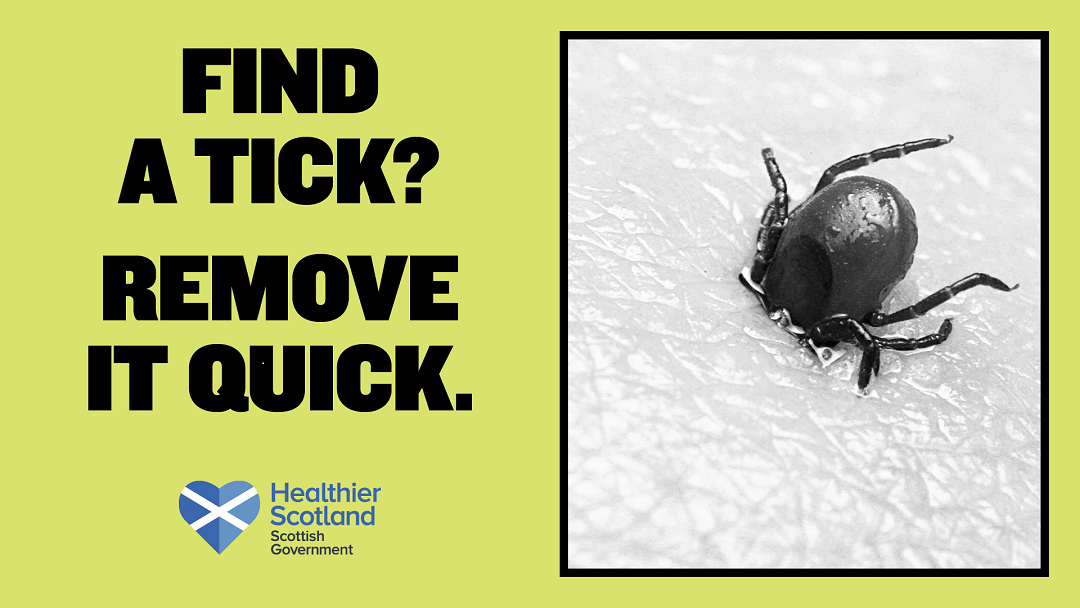A new campaign has launched to raise awareness of tick bites and the symptoms of Lyme disease in a bid to encourage people to take precautions this summer.
With a new survey revealing over half of people in Scotland (54 per cent*) don’t know what to do when bitten by a tick, the Scottish Government campaign drives home the importance of acting quickly if a tick is found on the body.
The research also highlighted how common tick bites are, with almost two thirds of people in Scotland (64 per cent) having been bitten by a tick, or knowing someone who has been bitten.
People across Lanarkshire are being encouraged to be aware of the early signs and seek medical advice if concerned to prevent serious infection.
Two thirds of people in Scotland (66 per cent*) aren’t aware of the earliest and most common symptoms of Lyme disease, which include a red circular rash on the skin, often described as looking like a bullseye on a dart board. People can also experience cold or flu-like symptoms such as tiredness, headaches and muscle or joint pain.
Ticks can be found throughout Scotland in wooded and grassy areas, so preventative measures when outdoors, such as sticking to pathways instead of going through long grass, using a repellent spray on clothing and not exposing skin can help reduce the risk of being bitten.
According to data, Scotland has 25% of UK cases of Lyme disease, and Professor of Molecular Microbiology for the University of Glasgow, Tom Evans, today reinforced that prevention is key to reducing the risk of serious infection:
“Ticks are in peak season in summer, and with people spending more time outdoors it’s important that they take steps to prevent becoming ill from Lyme disease.
“If you do get bitten, you should remove the tick as soon as possible to prevent infection. Using fine-tipped tweezers to gently grip the tick as close to the skin as possible, pull it steadily away from the skin without twisting or crushing it. Special tick removers are also available from most pharmacies. You should wash the area with water and soap afterwards and apply an antiseptic cream.
“Lyme disease can be difficult to detect, and while most cases are mild, if not found early it can have serious and lifelong side effects. Therefore it’s really important to be aware of any symptoms in the weeks following a tick bite so it can be effectively treated.”
Heather Knox, Chief Executive at NHS Lanarkshire shared her personal story:
“I was diagnosed with Lyme disease last year after being bitten by a tick from the deer that come into our garden. I had flu like symptoms and a high temperature for several days followed by the Lyme disease rash. Looking back now I was actually quite lucky that I was diagnosed so quickly and given antibiotics. I think it could have been a lot worse. I have now installed a deer fence and I am very careful to wear long trousers when out walking. Hopefully my story helps to raise awareness amongst others to take care and follow the advice.”
Dr Claire McGoldrick, Consultant Physician in Infectious Diseases at University Hospital Monklands added:
“NHS Lanarkshire are proud to support this campaign as we see a rising Scottish incidence of tick-borne infection, which many people have little or no prior knowledge of.
“Being tick-aware and ensuring prompt tick removal where these are found is important when exploring both the local area, particularly in parkland and in more rural locations, and when travelling further afield. Keeping a tick-removal device handy should become the new norm.
“The physical and mental health benefits of exploring the great outdoors are immense, and we encourage people to get out there. This important campaign arms the public with simple and effective information to prevent Lyme disease, as well as some information on how to recognise the signs.
“So we urge people to enjoy the great outdoors while being TICK-AWARE!”
Health Secretary Humza Yousaf said:
“We definitely want people to spend time in Scotland’s beautiful outdoors, but with tick populations especially high in the summer months, we also want to make sure people do so safely.
“Ticks can be found all over Scotland so wherever you are spending time outdoors this summer, taking measures to prevent bites, knowing what to do if you are bitten, and being able to recognise the signs of Lyme disease will help avoid infection.
“More information about ticks and Lyme disease is available at NHS inform, and we’ve also placed information posters in pharmacies across Scotland where you can go for more advice about ticks.”
For more information about ticks visit nhsinform.scot/lyme-disease
* Includes respondents that selected ‘No’ and ‘Not sure’
Top tips people can take when in outdoor green spaces this summer:
- Check for ticks following time spent outdoor in green spaces. Ticks are very small and therefore very hard to spot. Doing a full body check is extremely important.
- Keep to footpaths and avoid long grass when out walking.
- Wear appropriate clothing (long-sleeved shirt and trousers tucked into your socks) when out in green spaces.
- Wearing light-coloured fabrics can help you spot ticks on your clothing.
- Use insect repellent on exposed skin.
- Remove a tick using fine-tipped tweezers or a tick removal card to gently grip the tick as close to the skin as possible. Pull steadily away without twisting or crushing. Wash the affected skin with soap and water and apply an antiseptic cream to the area of skin around the bite.
- Lyme disease is easier to treat the earlier it is diagnosed, so look out for the early and most common symptoms which include include a red circular rash on the skin, like a bullseye on a dart board, and cold or flu-like symptoms such as tiredness, headaches and muscle or joint pain.

